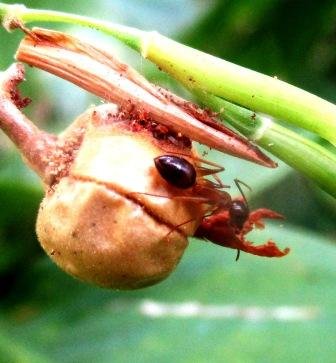
Frogs and frogs start their lives as eggs placed in their mother's water, in foam nests, or in other wet places. Some types of mountain frogs store their eggs among moss that is wet in trees. While other types of forest frogs leave their eggs on the back of a moist male toad, which will always take care and carry them until they hatch even into small frogs. Once laying frogs can produce 5000-20000 eggs, depending on the quality of the parent and lasts three times a year .
Frog eggs and frogs hatch into tadpoles or tadpoles (b. English: tadpole), which are fat fish-like bodies, breathe with gills and live for a while in the water. Slowly you will grow your hind legs, which are followed by the growth of the front legs, the disappearance of the tail and the change of gills with the lungs. After his time, this tadpole will jump ashore as a frog or a small frog.
Frogs and frogs mate at certain times, for example when the moon is dead or when it is raining. At that time the male frogs will sound to call the female, from the edge or middle of the water. Some types, such as moor frog (Fejervarya limnocharis) and sticky kintel aka belentung (Kaloula baleata), often form the 'singing group', where several male animals gather close together and sound muttering. A frog's loud noise is produced by a sound bag located around its neck, which will bulge when used.
Fertilization in frogs is done outside the body. The male frog will attach to the female's back and hug tightly the armpit of the female from behind. While swimming in the water, the hind feet of the male frog will massage the female toad's stomach and stimulate the release of eggs. At the same time the male frog will release its sperm into the water, so it can fertilize the eggs released by the female.

Then how about the life of ants
The body of the ant consists of three parts, namely the head, mesosoma (chest), and metasoma (stomach). The morphology of the ant is quite clear compared to other insects, and the second part of the stomach that connects to the ant stalk forms a narrow (peduncle) waist between the mesosoma (the chest cavity and abdominal region) and metasoma (the abdominal abdomen in the petiole). Petiole can be formed by one or two nodes (only the second, or the second and third abdominal segments can be realized).
The body of ants, like other insects, has an outer frame that provides protection and also as a place to attach the muscles, in contrast to human and animal skeletons. they have breathing holes in the chest called spiracles for air circulation in their respiration system. Insects also do not have a closed circulatory system. Instead, they have long, thin ducts along the upper part of their body called "back aorta" which function similar to the heart. the ant consists of a kind of ventral nerve muscle that is along its body, with several branches connected to every part of its body.
Hopefully this simple science is useful
FOLLOW ME
Congratulations @winjaya! You have completed the following achievement on the Steem blockchain and have been rewarded with new badge(s) :
Click on the badge to view your Board of Honor.
If you no longer want to receive notifications, reply to this comment with the word
STOPDo not miss the last post from @steemitboard: